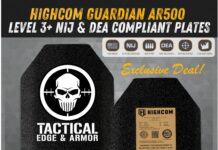It is easy to see why the PDW, the Personal Defense Weapon, has become such a mainstay in the modern gun owner’s lineup. That weapon type is exactly the system some looking for an effective protective system would be considering.
Small for mobility.
Easy to use.
Controllable recoil.
More accurate than a handgun with greater effective range.
9-Hole goes over the 4 identifiable types of PDW, from the rear echelon weapon the the M1 carbine and M4 carbine were originally designed to be, to the compact hybrid type weapons of the MP7 and P90, to the Pistol Caliber Carbine/Sub Guns, to the modern rifle caliber micro platforms like the AK74su and MK18.
In reality, a modern 16″ carbine (using the loose definition of 16 that can include unmodified barrels to pin and welds) will fulfill the role of homestead rifle very nicely. I love 13″-14.5″ barreled guns in rifle calibers, it’s a happy middle ground. But there are still places where the super shorties, the pistol calibers, and the oddballs live 5.7x28mm have a strong niche.
The PDW is designed to be the most portable of CQB carbines. For fighting at traditional pistol distances and a little beyond, it is the both highly portable, more concealable, and convenient for those using them.
Now there are different types of PDW’s, these types are based on the priority of the design. The M1 Carbine, for example, was a rear echelon firearm, as was the P90 design. The MP7 is designed to fill the gap between a holstered sidearm and a slung carbine by operating in both roles, the Flux Defense designs are in that same use theory also.
PDW is a broad category that is outside a traditional fighting rifle. A Traditional fighting rifle is an overt weapon system for combat arms troops. The PDW covers a spectrum of specialized roles where there is a clear priority in addition to effectiveness in a fight, usually concealability, portability, or both. These weapons are also specifically designed to be used in the defense role. Responding to an attack against troops behind the line, an attack on a VIP, an assault against a small low-profile security element, an attack against undercover officers, use by officers or troops who cannot transport a larger rifle like those on a bike, atv, or jet-ski, or use in a limited space environment like inside a house or vehicle.
PDW’s can be used offensively by troops, however their design elements focus on reactive actions. The MK18, for example, is a design for making a compact useable suppressed carbine shorter than the M4, it can be used for covert offense or defense. It could also be used for compact defense with modifications like the LAW folder. It isn’t limited to the PDW designation but can very much fill the role.
Ultimately that is what PDW is, a role and not a weapon. The 20″ M16 like rifle you have for home defense is a PDW if used in the role, is it ideal? Perhaps and perhaps not, but it is pressed into the role. The X95 Carbine is one of my preferred PDW’s, but it is a regular service rifle with the IDF. In the US it is an SBR, but so is the M4/M4A1 another preferred PDW. For the role of travel GAT I usually use a CZ Scorpion EVO3 or an XCR as the both fit nicely in a bag. Those are more traditionally fitting the role of PDW in the convenience and discretion of transport elements.
Ultimately, PDW’s broad definition could clash with the specified jobs of a specific firearm within a specific agency, element, or personal owner. It could be a PDW+, more than just a PDW.
So what is a PDW?
In short, a carbine type firearm larger than a traditional sidearm intended for a defensive role, protecting persons or property, that has been optimized for portability, concealment, or both.



